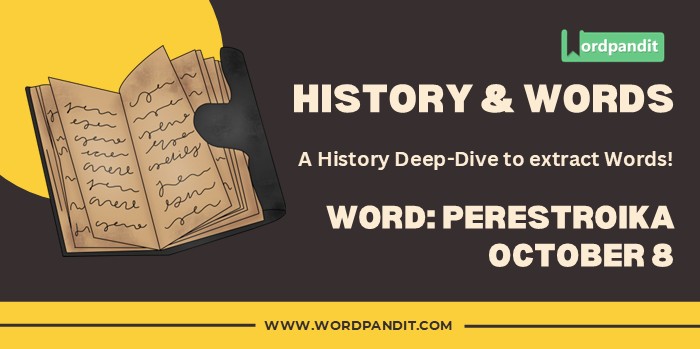History & Words: 'Perestroika' (October 8)
Welcome to 'History & Words.' 🌟 I'm Prashant, founder of Wordpandit and the Learning Inc. Network. This series combines my passion for language learning with historical context. Each entry explores a word's significance on a specific date, enhancing vocabulary while deepening understanding of history. Join me in this journey of words through time.
📚 Table of Contents
- Word of the Day
- Introduction
- Etymology
- Key Vocabulary
- Historical Context
- Timeline
- The Day's Significance
- Quote
- Modern Usage and Reflection
- Legacy
- Comparative Analysis
- Did You Know?
- Conclusion
- Further Reading
📚 Word of the Day: Perestroika
Pronunciation: /ˌpɛrəˈstrɔɪkə/ (peh-ruh-STROY-kuh)
🌍 Introduction
On October 8, 1987, Soviet leader Mikhail Gorbachev made an announcement that would reshape the course of history. He introduced the policy of perestroika, or "restructuring," a bold initiative aimed at reforming the Soviet Union's stagnant economy and rigid political system. This moment marked a pivotal shift in the Cold War era and set in motion a series of events that would ultimately lead to the dissolution of the Soviet Union.
The term "perestroika" encapsulates more than just a policy; it represents a fundamental reimagining of the Soviet system. It signaled a recognition that the centralized, state-controlled economy was failing to meet the needs of Soviet citizens and that political reforms were necessary to revitalize the nation. Gorbachev's vision of perestroika was coupled with glasnost, or "openness," fostering unprecedented transparency and freedom of expression within the Soviet Union.
The announcement of perestroika on this day in 1987 sent shockwaves through the Soviet Union and the world at large. It represented a dramatic departure from decades of Soviet policy and ideology, offering hope for change within the USSR and the possibility of improved relations with the West. However, the path of reform would prove to be complex and fraught with challenges, ultimately contributing to the unraveling of the Soviet system itself.
🌱 Etymology
The word "perestroika" is of Russian origin. It combines the prefix "pere-," meaning "through" or "again," with "stroika," meaning "building" or "construction." Thus, perestroika literally translates to "rebuilding" or "restructuring."
In Russian, "stroika" is derived from the verb "stroit'" (to build), which has Indo-European roots. The prefix "pere-" is commonly used in Russian to indicate transformation or repetition, similar to "re-" in English.
📖 Key Vocabulary
- 🔑 Glasnost: The policy of increased transparency and freedom of information, introduced alongside perestroika.
- 🔑 Soviet Union: The Union of Soviet Socialist Republics (USSR), a socialist state that existed from 1922 to 1991.
- 🔑 Centralized economy: An economic system where the state controls production and distribution of goods and services.
- 🔑 Cold War: The state of geopolitical tension between the Soviet Union and the Western Bloc, particularly the United States, from 1947 to 1991.
- 🔑 Democratization: The process of introducing democratic practices or systems of government.
🏛️ Historical Context
The announcement of perestroika in 1987 came at a critical juncture in Soviet and global history. By the mid-1980s, the Soviet Union was facing severe economic stagnation. Despite being a superpower in terms of military might, the USSR struggled to provide basic consumer goods to its citizens, and its technological development lagged behind the West.
The roots of these problems could be traced back to the rigid, centrally planned economic system established under Joseph Stalin in the 1920s and 1930s. While this system had initially driven rapid industrialization, by the 1980s it was proving increasingly inefficient and unable to adapt to changing global economic conditions.
Politically, the Soviet Union had been governed as a one-party state since its inception, with power concentrated in the hands of the Communist Party. This system had become increasingly ossified, with an aging leadership resistant to change and a bureaucracy more focused on maintaining its own power than addressing the needs of citizens.
Internationally, the Cold War had dominated global politics for decades. While there had been periods of détente, by the early 1980s tensions between the Soviet Union and the West had risen again, with both sides engaged in a costly arms race.
Gorbachev's rise to power in 1985 represented a generational shift in Soviet leadership. Unlike his predecessors, he recognized the need for significant reforms to address the USSR's deep-seated problems. Perestroika was his ambitious attempt to revitalize the Soviet system without fundamentally altering its socialist character.

⏳ Timeline
- 1917: Russian Revolution establishes the world's first socialist state
- 1922: Formation of the Soviet Union
- 1928: Joseph Stalin introduces the first Five-Year Plan, beginning the era of centralized economic planning
- 1953: Death of Stalin; beginning of a period of de-Stalinization under Nikita Khrushchev
- 1964: Leonid Brezhnev comes to power, initiating a period of economic stagnation
- March 1985: Mikhail Gorbachev becomes General Secretary of the Communist Party
- April 1985: Gorbachev introduces the concept of perestroika in a speech
- February 1986: Gorbachev formally proposes perestroika at the 27th Congress of the Communist Party
- October 8, 1987: Gorbachev announces specific policies of perestroika
- 1989: Fall of the Berlin Wall; revolutions in Eastern Europe
- 1991: Dissolution of the Soviet Union
🌟 The Day's Significance
October 8, 1987, stands as a watershed moment in the history of the Soviet Union and the Cold War. On this day, Mikhail Gorbachev, in a speech to the Central Committee of the Communist Party, outlined specific policies and goals of perestroika, giving concrete form to the concept he had been developing since coming to power in 1985.
The significance of this announcement cannot be overstated. It represented a formal acknowledgment by the Soviet leadership that their system, long presented as the ideal model of socialist development, was in need of fundamental reform. This admission was revolutionary in itself, challenging decades of Soviet orthodoxy.
Gorbachev's vision of perestroika encompassed both economic and political reforms. Economically, it aimed to introduce elements of market economics into the Soviet system, allowing for some private ownership and loosening central control over production and pricing. Politically, it sought to democratize the Soviet system, reducing the power of the Communist Party bureaucracy and introducing competitive elections.
The announcement of these policies sent shockwaves through Soviet society and the international community. Within the USSR, it sparked hope for change among reformers but also anxiety and resistance from conservative elements who feared the loss of their privileged positions. Internationally, it signaled a dramatic shift in Soviet policy, opening the door for improved relations with the West and reduced global tensions.
However, the path of perestroika would prove to be fraught with challenges. The reforms unleashed forces and expectations that Gorbachev and his allies struggled to control. Economic changes led to shortages and inflation, while political openness allowed long-suppressed nationalist sentiments to surface in many Soviet republics.
💬 Quote
"We need revolutionary change, but we need evolutionary implementation." - Mikhail Gorbachev
🔮 Modern Usage and Reflection
Today, "perestroika" remains closely associated with the final years of the Soviet Union and the transformative policies of Mikhail Gorbachev. In broader usage, it can refer to any process of restructuring or reform, particularly in a political or economic context.
The legacy of perestroika continues to be debated. While it's widely credited with ending the Cold War and bringing unprecedented freedoms to Soviet citizens, it's also associated with the economic hardships and political instability that accompanied the collapse of the Soviet system.
In contemporary Russia, attitudes towards perestroika are mixed. Some view it as a necessary and courageous attempt at reform, while others see it as a misguided policy that led to the dissolution of the Soviet Union and a period of national humiliation.
🏛️ Legacy
The legacy of perestroika extends far beyond the borders of the former Soviet Union. It played a crucial role in ending the Cold War, reshaping global geopolitics in the process. The reforms initiated under perestroika contributed to the fall of communist regimes across Eastern Europe in 1989 and ultimately to the dissolution of the Soviet Union itself in 1991.
In the realm of international relations, perestroika led to a thawing of Cold War tensions, paving the way for arms reduction treaties and increased cooperation between East and West. It also sparked a rethinking of socialist economics worldwide, influencing reform movements in countries like China and Vietnam.
Within Russia and other former Soviet republics, the impact of perestroika continues to be felt. The transition from a centrally planned economy to a market system, initiated under perestroika, has shaped these countries' economic and political development over the past three decades.
🔍 Comparative Analysis
When Gorbachev announced perestroika in 1987, it was seen as a bold and potentially transformative policy. There was hope, both within the Soviet Union and internationally, that it could revitalize the Soviet system while maintaining its socialist character.
In retrospect, the challenges of implementing such sweeping reforms in a system as entrenched as the Soviet Union's were perhaps underestimated. The experience of perestroika highlighted the difficulties of managing controlled change in a highly centralized system.
Compared to other historical reform movements, perestroika stands out for its ambitious scope and its ultimate unintended consequences. While it shares some similarities with China's economic reforms initiated in the late 1970s, the political openness that accompanied perestroika distinguishes it from the Chinese model.
💡 Did You Know?
🎓 Conclusion
The announcement of perestroika on October 8, 1987, marked a turning point in world history. Mikhail Gorbachev's bold attempt to reform the Soviet system set in motion a series of events that would reshape the global order. While perestroika ultimately contributed to the dissolution of the Soviet Union rather than its revitalization, its impact on promoting peace, freedom, and international cooperation cannot be understated. As we reflect on this pivotal moment, perestroika serves as a powerful reminder of the complexities of reform and the unpredictable nature of historical change.
📚 Further Reading
- 📘 "Perestroika: New Thinking for Our Country and the World" by Mikhail Gorbachev
- 📗 "The Last Empire: The Final Days of the Soviet Union" by Serhii Plokhy
- 📙 "Why Perestroika Failed: The Politics and Economics of Socialist Transformation" by Peter J. Boettke












